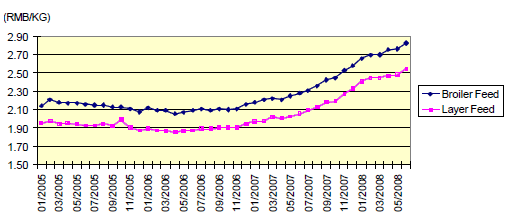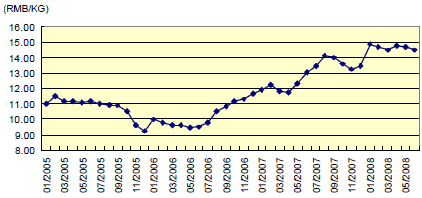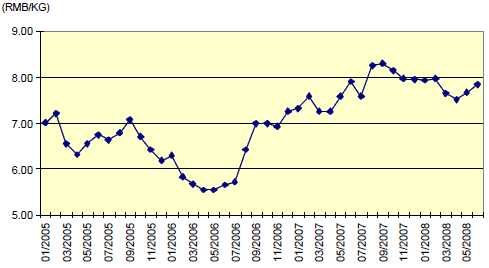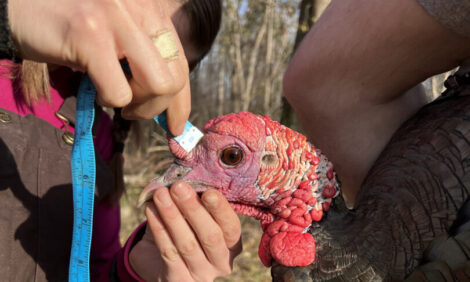



Peoples Republic of China Poultry and Products Annual Report 2008
China's broiler production in 2009 is forecast to increase eight per cent to 13.7 million tonnes, according to the USDA Foreign Agricultural Service (FAS). Broiler imports in 2009 are forecast to be at the same level as 2008. Broiler exports are forecast to recover three per cent to 283,000 tonnes from the previous year's 23 per cent decline.Report Highlights
On July 1, 2008, China lifted its poultry ban on Connecticut, Rhode Island, Pennsylvania, West Virginia, and Nebraska. Imports from these states were suspended several years ago because of outbreaks of low pathogenic avian influenza. The ban on New York State was officially lifted on August 24, 2008. Lifting of these bans will provide more opportunities for U.S. exports to China. China's broiler production in 2009 is forecast to increase eight percent to 13.7 MMT. Broiler imports in 2009 are forecast at the same level as 2008. Broiler exports are forecast to recover three percent to 283,000 MT from the previous year's 23 percent decline.
Executive Summary
On July 1, 2008, China lifted its ban on poultry exports from five U.S. states: Connecticut, Rhode Island, Pennsylvania, West Virginia, and Nebraska, which were suspended several years ago because of low pathogenic avian influenza (LPAI) outbreaks in these states. Removal of the bans will provide new opportunities for U.S. exports to China. The New York State ban was officially lifted on August 24, 2008. It is uncertain when the bans on Virginia and Arkansas will be lifted.
While 2009 pork production is not expected to fully recover from the losses caused by porcine reproductive respiratory syndrome (PRRS or blue ear disease) during latter half of 2006 and the first half of 2007, 2009 broiler meat production is forecast up at 13.7 million metric tons (MMT), an increase of eight percent over the previous year. Production in 2009 is expected to remain strong, because poultry meat is a substitute for pork.
Broiler meat imports in 2009 are forecast to remain flat, at the same level as in 2008. Domestic production increases, continued slow recovery of pork production, and little growth in exports following the 21-percent decrease in 2008 will contribute to increased domestic supplies. This in turn is expected to constrain China’s imports of broiler meat in 2009. Chicken paw imports will remain stable and continue to enjoy steady consumer demand.
Broiler meat exports in 2009 are forecast to recover just five percent over the previous year because of a predicted decrease in exports to Japan due to stricter quarantine requirements. Japan is a traditional export market for China.
Production
Broiler Production Forecast to Continue to Increase in 2009
China’s broiler meat production in 2009 is forecast to increase eight percent to 13.7 MMT over the revised 2008 estimate of 12.7 MMT, and 11 percent above the previous estimate. This increase is mainly attributed to a sharp decline in pork production in 2006 and 2007 caused by outbreaks of PRRS. The pace of growth in 2009 appears below that of 2008 because of slightly recovering pork production. The eventual recovery will no doubt weaken broiler meat consumption as a substitute for pork.
The May 2008 earthquake in Sichuan Province, which resulted in about 100,000 human deaths and caused significant economic losses, did not drastically impact China’s broiler production. Sichuan Province is not one of China’s largest producing provinces.
China’s 2007 poultry production is revised down to 11.4 MMT from the previous forecast of 11.5 MMT, because imports of grandparent generation breeding stocks in 2006 were not as high as originally expected. In 2008, production is revised up to 12.7 MMT from the previous forecast of 12.5 MMT based on China’s increasing imports of breeding stock (please refer to CH8013 for more information). Because China imports almost all western-bred (also called white-feathered broiler) grandparent generation breeding stocks from abroad, mainly from the United States, import volume is an important factor used to predict China’s broiler production.
According to the Chinese poultry industry, China imported 340,000 sets (one set = 120 birds), 410,000 sets, and 405,600 sets of grandparent generation breeding stocks in 2004, 2005, and 2006 respectively, most from the United States. Production growth slowed during this period due to outbreaks of SARS in 2003, and highly pathogenic avian influenza (HPAI) in 2004 and 2005 China. Broiler production began increasing when mass outbreaks of PRRS occurred in China during the second half of 2006 and the first half of 2007. According to new official data from the Second National Agriculture Census by the National Statistics Bureau (NSB), during 2006-2007 PRRS caused a seven and eight percent decrease in China’s pork production, respectively. At the same time, HPAI outbreaks were reduced considerably thanks to the government’s free compulsory HPAI vaccination and subsidies to farmers to cull infected birds, which made poultry farmers more willing to cull to prevent further spread of the disease.
As the second largest meat protein consumed and the least expensive meat when compared with red meats1 in China, broiler meat has become an important substitute for pork. However, flat imports of grandparent generation breeding stocks at the end of 2006 constrained broiler production in the first few months of 2007. Although breeding stock imports increased by 39 percent to 565,700 sets in 2007, most were in the latter half of the year, which benefited 2008 production rather than 2007. According to the China Poultry Association, China imported six varieties of broiler grandparent generation breeding stocks in 2007, AA (44.8 percent), Ross (27.3 percent), AB48 (4.8 percent), Bobb500 (4.7 percent), Hybro (1.3 percent), and Hubbard (0.9 percent). The market share will not significantly change in 2008 and 2009.
1 For purposes of this report, red meat is defined as beef, pork, sheep, and goat meat.
New Law on Corporate Income Tax Impacts Poultry Rearing
China’s new corporate income tax policy became effective on January 1, 2008. The law exempts companies involved in animal or poultry rearing from paying income taxes. This incentive has attracted both domestic and foreign investments in China’s poultry cultivation. For example, Tyson Foods, a U.S. company, recently initialed a preliminary agreement with Xinchang Group, near Qingdao in Shandong Province, to set up a joint-venture to raise broilers. Sunner, a Chinese company in Fujian Province, has invested in several new farms and facilities in order to meet its slaughter capacity goal of 102 million birds per year by 2010. China’s tight monetary policy aimed at curbing inflation has made it more difficult to obtain domestic financing for new poultry production facilities, making foreign investment in these projects more attractive. The broiler production cycle is also much shorter compared with that for cattle and swine. When feed grain prices increase as they have been, broiler rearing is more economical because the conversion rate between feed and broiler meat is 2:1, while pork is 3:1 and beef is 8:1 according to the poultry industry.
Feed Increase Benefits Broiler Production

($1=RMB6.9)
China’s total feed production in 2007 reached 117 MMT. This is the 12th consecutive year China has ranked second in world feed production, behind the United States. The production from January to June 2008 is estimated at 59 MMT, an 11-percent increase over the same period in 2007. Out of this, compound feed increased 13 percent to 45.5 MMT, concentrated feed increased four percent to 11.2 MMT, and additive pre-mixed feed increased six percent to 2.4 MMT, respectively. Broiler feed increased nearly 21 percent to 19 MMT. Broiler production in China is the most industrialized, compared with the swine and cattle sectors, and benefits from a reliable feed supply.
However, the price of feed grains is the major concern for China’s broiler industry in 2009. From January-June 2008, China’s retail broiler feed prices2 increased 23 percent to 2,730 RMB (currently about U.S. $420) per ton over the same period in 2007, and 31 percent over 2006. Grain and soybean prices on the international market are expected to remain at high levels through at least the end of 2008. China is a net importer of soybeans and soybean meal products for feed production. This heavy dependence on imports, combined with overall price increases in oil, energy, water, and labor supplies domestically, will put more pressure on China’s domestic poultry production.
2 For this report, RMB has been used to track poultry and feed product prices. Exchange rate fluctuations between the dollar and the RMB make feed price quotes in dollars less accurate.
Prices Falling From High in April

($1 = RMB6.9)
Strong domestic demand began pushing up China’s broiler meat prices in July 2007. The chart below demonstrates the increase in retail broiler meat prices from January to June 2008. Prices increased by 20 percent on average to $214 per MT (1,470 RMB) per MT over the same period in 2007. Prices dropped from a high of $374 per MT (2,574 RMB) in April to $163 per MT (1,119 RMB) in June 2008 because of increased broiler production and higher broiler imports. Summer tends to be a low meat consumption season in China, and contributed to the deflation of prices. NSB indicates that the growth of China’s Consumer Price Index (CPI) dropped to 6.3 percent in July, the lowest since September 2007, thanks to a good summer grain harvest and government steps to boost China’s meat production. Policies such as corporate income tax exemption and breeding sector subsidies are paying off. Average meat prices rose by 16 percent in July, compared with increases of 27.3 percent in June and 30.7 percent in May 2008. Broiler prices are expected to continue falling during the remainder of 2008.
Consumption
China’s broiler meat consumption in 2009 is forecast to increase by eight percent to 13.9 MMT, following an estimated 12-percent increase to 12.8 MMT in 2008. Both increases are the result of broiler substitution for pork, following the 2006 and 2007 decline in pork production due to disease outbreaks. Out-of-home dining also contributes significantly to this change in consumption. In January 2008, China changed its May Day holiday from three days to one day, and created an additional three long weekend holidays combined with traditional Chinese festivals (no days off were granted for these holidays in the past). One “golden-week holiday” was replaced by four long-weekend holidays. As a result of these additional days off of work, consumers have more chances to gather together with friends and family and eat at restaurants. Members of China’s busy younger generation love western fast food like Kentucky Fried Chicken or McDonalds. Although KFC raised its prices in March and August 2008 because of increased labor, packaging, and transportation costs, members of this generation are largely not price-sensitive and sales have remained stable.
Trade
Poultry Ban Lifted on Six U.S. States
China suspended exports from a total of eight U.S. States due to outbreaks of low pathogenic avian influenza (LPAI). On July 1, 2008, AQSIQ notified FAS/Beijing the ban would be lifted on five U.S. States: Connecticut, Rhode Island, Pennsylvania, West Virginia, and Nebraska. The ban on Virginia remains in place and a ban on Arkansas was announced on July 1, 2008, also triggered by an LPAI outbreak. The New York ban was officially lifted on August 24, 2008, following an internal letter from AQSIQ to the local Entry-Exit Inspection and Quarantine Bureau (CIQ) offices without notification to FAS/Beijing or USDA. Removal of these bans will provide more opportunities for U.S. plants to export poultry products to China.
The bans were lifted largely as a result of strengthened communication and exchanges between USDA, FAS/Beijing, and the USA Poultry and Egg Export Council (USAPEEC) with AQSIQ and the Chinese poultry industry. USDA and AQSIQ are working on a bilateral Memorandum of Understanding (MOU) on food safety cooperation and continue to hold a food safety bilateral meeting once a year. USAPEEC also regularly hosts a seminar on heath management during processing with AQSIQ/CIQ officials. After the Sichuan earthquake, USAPEEC and some U.S. poultry companies donated over $230,000 to China to aid in disaster relief.
Broiler Imports to Remain Flat in 2009
The estimated increase of domestic broiler production, combined with continued recovery of pork production and a slow recovery of cooked poultry exports to Japan will likely result in flat broiler imports in 2009. In addition, China temporarily reduced import tariff rates from June 1 to December 31, 2008 to increase supply and alleviate high meat prices in China. As China’s CPI decreases, import tariff rates may return to normal levels. The expected increase in import costs and decrease in sales are likely to constrain imports in 2009.
Although China’s total broiler imports from January to June 2009 increased over the same period in 2007, the largest increase is in chicken paw imports. Frozen cut parts decreased by seven percent, mainly due to a decline in imports from Brazil. China suspended imports from Brazil out of concern exports were originating from plants not registered by AQSIQ. Currently, only one Brazilian plant is eligible to export to China, but its export volume far exceeds its production ability. As a result of Brazil’s suspension, the United States has capitalized on a portion of Brazil’s lost market share. U.S. exports of meat and chicken paws to China during the first half of 2008 increased by 19 percent to 280,008 MT, valued at $359.9 million, and account for 72 percent of China’s total imports via direct shipments. Hong Kong re-exports to China during the first half of 2008 increased by 114 percent, valued at $25.8 million (HK$201 million) and account for 18 percent of Hong Kong’s total reexports to China. However, U.S. exports were unable to fill the gap left by fewer Brazilian exports of cut parts, Brazil’s manual cut and soldier layer packing of whole chicken wings are very competitive in the market. The United States is expected to continue to be the largest supplier of China’s imports in 2009.
Breeding Stock Imports Up Sharply, the United States a Dominant Supplier
From January to June 2008, China’s imports of grandparent generation breeding broilers increased 67-percent to 941,091 birds over the same period in 2007. This sharp increase is proportionate to the decline of China’s pork production, reflecting the inverse relationship between broiler and pork production. As pork production is not expected to fully recover to pre-PRRS levels in 2009, imports will continue. This will benefit U.S. exports to China because the United States is a dominant supplier, accounting for 87 percent and 95 percent market share in 2007 and in the first six months in 2008.
Processing Trade to Ban Frozen Poultry Wings and Paws
China prohibits imports of frozen chicken wings, paws, offal, as well as frozen turkey segments and offal to be used for processing and re-export, according to the 2008 catalogue of banned commodities for the processing trade. Processing these products for re-export is prohibited because the profit margin is low when high energy and water costs for processing are taken into account. The publication was issued in 2008 by the Ministry of Commerce and the General Administration of Customs (www.mofcom.gov.cn). This does not impact the United States because it does not export these products for processing and re-export.
Exports up Slightly After Previous 23 Percent Decrease
China’s 2009 broiler exports are forecast to increase by five percent to 288,000 MT, a slight recovery from the 23-percent decrease in total exports in 2008. China’s cooked broiler exports to Japan in 2009 are expected to recover only two percent from the 33 percent decrease in 2008. Japan is traditionally China’s largest export market, accounting for 61 and 57 percent, respectively of China’s total broiler exports in 2006 and 2007. In early spring 2008, Japan changed its import testing policy and now applies more strict testing for nitro furans on imported broiler products, employing a near zero tolerance policy. This new policy has limited China’s exports over the short-term. It is unclear whether this policy will persist and how much it will impact China’s exports to Japan over the long term.
On May 8, 2008, Japan confirmed registration of 35 eligible Chinese plants to export cooked meat from even-toed animals to Japan. Currently, Japan has registered a total of 114 Chinese plants for export of cooked meat, 91 plants solely export cooked poultry. This is not expected to change the trade pattern considerably because Japan’s stricter inspection and quarantine, combined with RMB appreciation, will continue to constrain China’s exports.
China’s broiler meat exports to Hong Kong in 2009 are forecast to increase by two to three percent to supplement the estimated decrease in live chicken exports (Please see below explanation). Export increases may come from non-traditional export markets. According to CIQ Shandong, the South African Ministry of Agriculture has approved and registered a total of 57 eligible Chinese cooked poultry plants for exports to South Africa, 25 in Shandong Province. On May 26, 2008, Kyrgyzstan resumed frozen broiler imports from Xinjiang, West China. It suspended imports after an HPAI outbreak in March 2008. These non-traditional markets are much smaller compared with exports to Japan and Hong Kong.
Live Chicken Exports Down
Live chicken exports to Hong Kong are expected to be adversely impacted by Hong Kong’s new policy on live chicken slaughter in wet markets. The Hong Kong Government now mandates a maximum of fifty live broiler selling booths at street wet markets, a ninety percent reduction. Sellers must also complete live chicken sales each day and can no longer keep live chickens at wet markets after the markets closes. This “daily finish-up” practice will be fully replaced by central slaughter in 2012. This policy will mainly impact China’s local bred (yellow-feathered) chicken exports from Guangdong Province.
Poultry Eggs

China’s total poultry egg production in 2009 is forecast to increase five percent to 28 MMT, one percent below the growth rate in 2008. Egg prices have fluctuated since the last quarter of 2007 due to over-supply. According to the Chinese Poultry Industry, China imported 23,787 sets of grandparent generation breeding stocks, a 16-percent increase from the previous year. Increased imports and domestic ally produced grandparent generation breeding stocks totaled 36,787 sets in 2007, which could provide 26.7 million sets of parent generation breeding stocks to produce 1.88 billion commercial chicks. Higher inventory of supplies pushed egg prices down to $1,137 per MT (7,840 RMB) in June 2008, down from a high of $1,205 per MT (8,310 RMB) in August 2007. As prices continue to fall and production costs continue to rise, the profit for the egg industry will narrow in the remainder of 2008. However, the average price from January to June 2008 was four percent higher over the same period in 2007. Since there are few substitutes for chicken eggs, egg production will continue to grow at a rate of about five percent despite low profits.
China is a net fresh egg exporting country. In the first half of 2008, exports to Hong Kong and Macau accounted for 89 percent of China’s total exports, and exports to the United States accounted for eight percent. Kuwait is a newly discovered market and accounted for two percent of China’s total exports. Spring 2008 also marked the first time China exported breeding eggs to Mongolia, which totaled 180,000 pieces.
Further Reading
| - | You can view the full report by clicking here. |
Other Reports in this Series
To view our complete list of 2008 Poultry and Products Annual Reports from USDA FAS GAIN, please click here
December 2008







